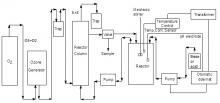
In this study, water-soluble disperse dyes [Disperse Violet 93 (DV93); Diffused Blue 79 (DB79); Disperse Orange 30 (DO30)] color removal by ozonation, which is one of the advanced treatment methods of synthetic dye waste solutions containing and whose decolorization conditions have not been investigated before, were investigated and the most suitable parameter criteria were determined. The experiments were carried out using a semi-batch reaction. The decolorization process of the reactive dye was carried out by bubbling ozone at the bottom of a bubble column reactor containing the dye solution. The effects of the ozonation time (0-120 min), the initial dye concentration (150-600 mg/L), ozone concentration (4.21-24.03 g/m3), the initial pH (2-12), and decolorization time was studied. As a result, COD values obtained from color measurements determined by the spectrophotometric method of disperse dye wastewater prepared synthetically after optimum conditions were achieved in experiments decreased by 61.05%, 72.88%, and 77.43%, respectively, and a significant color removal occurred under basic conditions (pH: 10 for DV93 and DB79; pH: 12 for DO30). For each dye processed separately, decolorization occurred within 16 minutes, 12 minutes, and 9 minutes, respectively. Ozonation kinetics were studied and it was found that decoloring showed first-order kinetics for the three dyes. The study showed that the apparent rate constant increased both at the applied ozone dose and under basic conditions, and decreased logarithmically with respect to the initial dye concentration. As a result of the study, it was determined that ozonation is a usable method for the treatment of azo dyes in textile wastewater; optimum conditions were determined for parameters such as the shortest time, optimum ozone dose, and appropriate pH range.
Total file downloads: 3